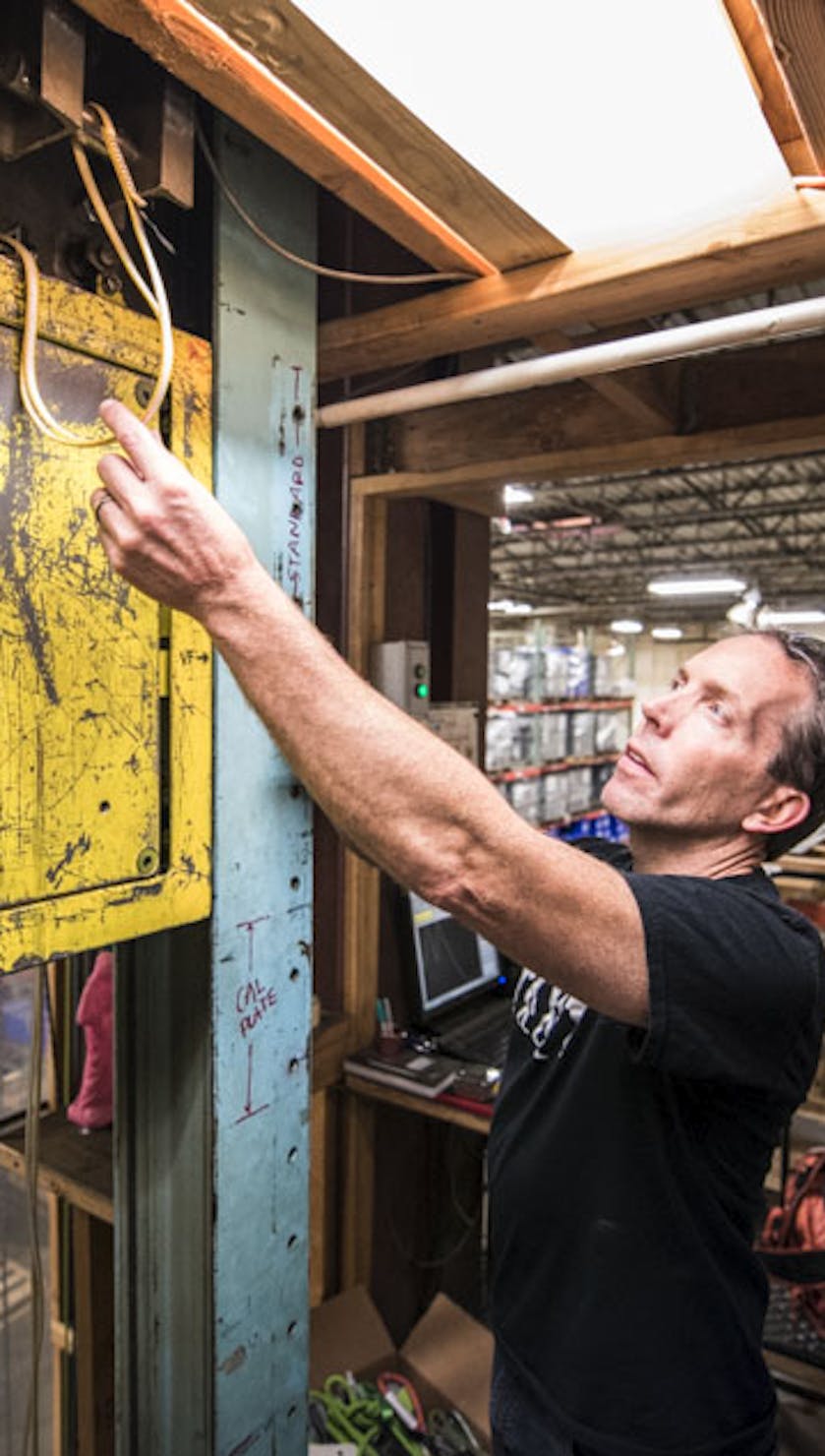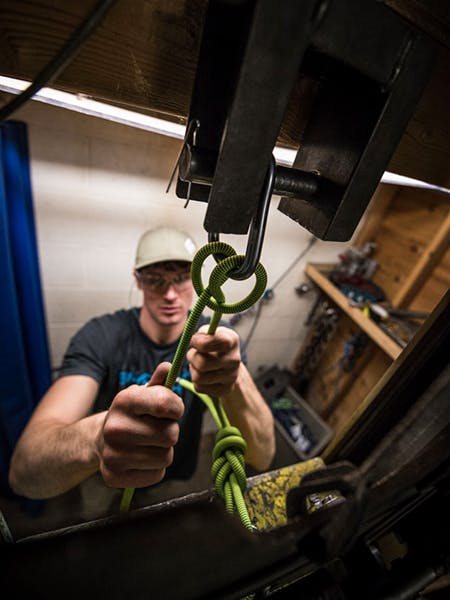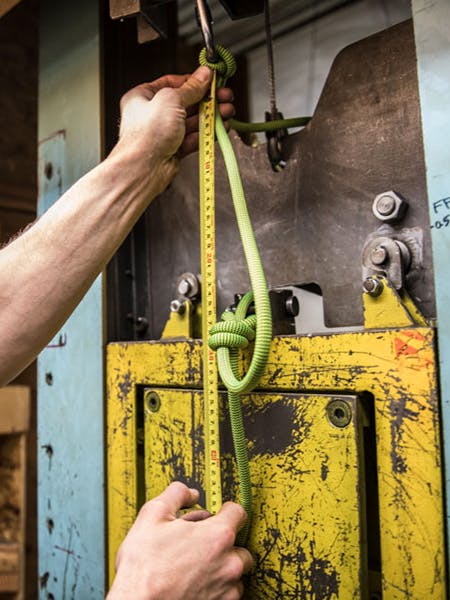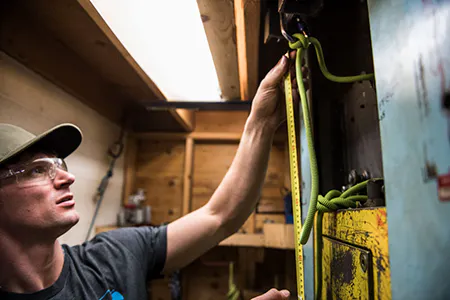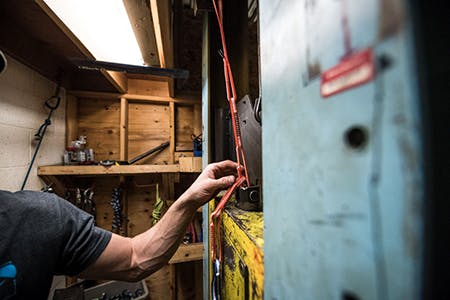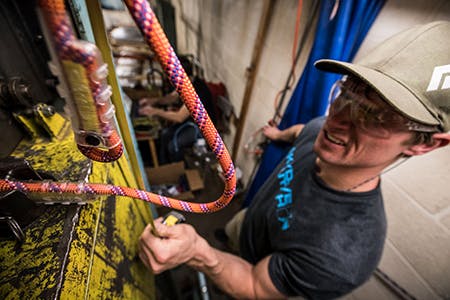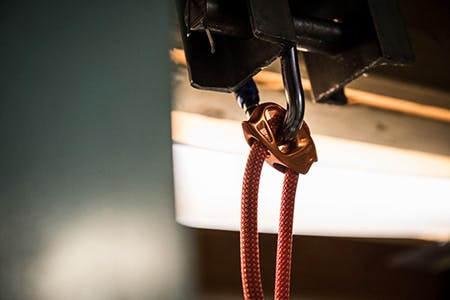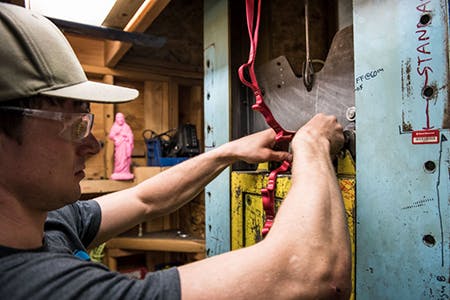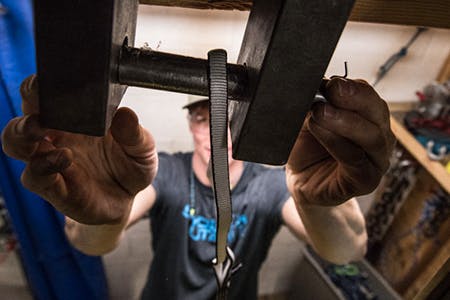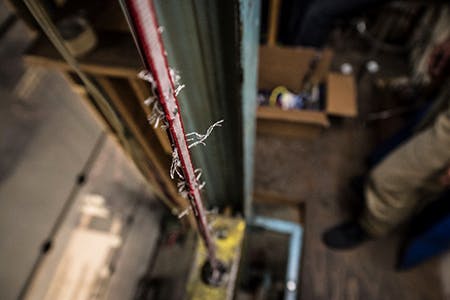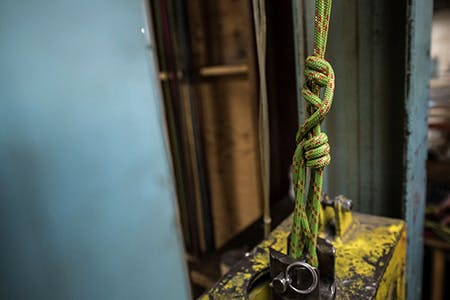I’m old-school. I clip in with draws when cleaning a sport anchor, I don’t wear a helmet when I’m sport climbing, and I use just the rope with a clove hitch to tie myself into the anchor when I get to the belay of a multi-pitch climb. When I’m rappelling off a route, I’ll use a couple of shoulder slings to tether myself in at each anchor. My personal philosophy is that I like having the least amount of stuff on me as possible, and the reality is I have the rope, and I have the slings—so why not use them?
Historically people have used daisy chains (incorrectly) as tethers. The pockets on daisy chains are typically quite weak—between 2-5kN, and the potential for mis-clipping a daisy (across the tack) is real:
Daisy chains should really be used for aid climbing and not as a personal tether.
So, what are people to do? Well, as climbing evolves, things change, and over the last several years “Personal Anchor Systems” (a nice descriptive term coined by our friends at Metolius) have really seemed to have taken over—especially with the next generation of climbers. And as always with change and new equipment or techniques, there are often questions that arise: “Do I wear it thong style?” (pro-tip: no). “How strong should a personal anchor system be?” “Can’t I just use a daisy chain?” “And what happens if I fall onto a Personal Anchor System?”
From what I’m hearing, climbers are generally concerned about the ultimate strength of the way they are securing themselves to an anchor. Climbers seem to really focus on the ultimate strength of things—like carabiners, cams, a knot, etc.— because it’s generally easy to understand. What is the strongest? Is it “full strength?”
There are many styles of these anchor systems sold, from sections of rope with sewn ends like a few styles from Beal, a device that incorporates a piece of rope from Petzl, a series of individual belay type loops sewn together into a continuous chain, either out of nylon or a dyneema/nylon combination, from Grivel, Metolius, Sterling, and BD. As well as many other different styles, I’m sure.
On the chain-of-loops style, sometimes there are no rated loop strengths, and sometimes there are—some are even rated to 22kN, as is the case with the Black Diamond Link Anchor System which allows it to be certified to the EN standard EN566:2006 as a sling. Because as I mentioned above, some folks like strong things. The attractiveness of these is that each loop on its own is ‘strong’ as opposed to a daisy chain which has typically weak loops or pockets.
Probably the most important thing to realize about using any type of these devices, or when you’re tied into the anchor in any fashion, is that they should be considered a TETHER. They are to secure yourself to the anchor—in case you were to slip, or need to hang for a hanging belay. That’s it. They’re not really intended to take a FALL. The reality is, if used properly and in typical climbing scenarios, these should rarely see over 2 or 3 times body weight at most. You should always try to avoid putting yourself into a situation where you could fall onto your tether. Because no matter what you’re using, the amount of material in the system is usually quite short. This means there isn’t much ability for the system to absorb energy and the loads can get high quickly. This can be hard on you, the climber, and on the anchor. Don’t fall onto your personal anchor system.
We’ve all probably heard by now that in general, Nylon absorbs more energy than Dynex because Dynex doesn’t stretch. But we figured we’d do some quick and dirty tests in the drop tower just to give you an idea of the differences in the load that the anchor sees—depending on which material you’re using.
DEFINITIONS
Personal Anchor System (PAS) – a trade name for the Metolius Personal Anchor System which has been adopted by the public as a generic term for these types of anchoring devices that allow you to tether yourself to an anchor.
Fall Factor – the distance you fall divided by how much rope or material you have in the system.
- • For example, if you're tied off with 1m of rope to the anchor, and are standing right at the same level as the anchor and fall, that’s – 1m/1m = FF1.
- • If you’re 1m above the anchor and fall, that’s a 2m fall, so 2m/1m = FF2.
- • If you’re tied into the anchor with 1m of rope, and are 50cm below the anchor and fall, then that’s a 50cm fall on 1m of rope, so 0.5/1 = FF0.5
Dynex/Dyneema/Spectra – for the sake of argument – all the same stuff – UHMWPE – (Ultra-high-molecular-weight polyethylene) low stretch, super strong, lower melting temperature than nylon. I’ll call it Dynex because that’s how we refer to it here at BD. In this case, all samples in this category tested were a combo of Dynex and Nylon. In general, Dynex is white, and Nylon has color.
THE TESTING
Disclaimer
I always need to put a disclaimer in here. The whole purpose of this column is to try and shed light onto some common questions. It is not intended to be a definitive study with conclusive results. If this info and data sparks conversations and gets people thinking about what they’re doing out in the hills, then mission accomplished.
We decided to look at two things:
- 1. Ultimate Strength
undefinedundefined - Ultimate strength is relatively easy to accomplish and relatively easy to understand, and people are always asking about it.
- 2. Dynamic Loading in the Drop Tower
- Yes, some drops. So really what I’m saying is we decided to test these things in a case of MIS-USE. That’s right—because as you recall from up above, you shouldn’t be falling onto these tethers. But what happens if you do?
Ultimate Strength Setup
- • We used our trusty tensile test machine that has about 70” of travel, loading at a rate of about 3”/min.
- • In most cases, we used our standard 10mm pins (representing the diameter of a carabiner).
- • In some cases, we also tested with the PAS girth hitched to the pin, harness tie-in points or the belay loop.
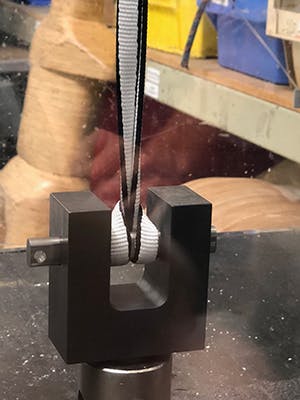
Girth hitched to 10mm pin
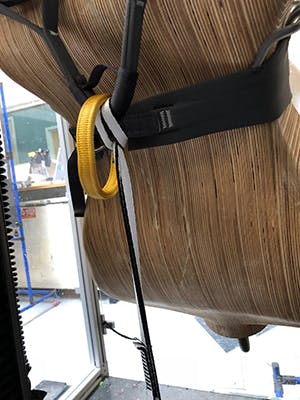
Girth hitched to BOTH tie-in points
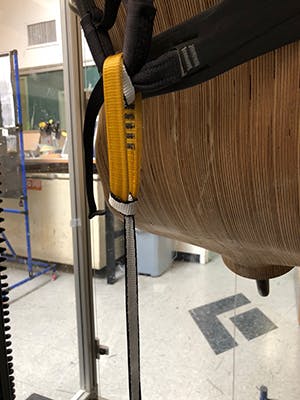
Girth hitched to belay loop
Drop Tower Setup
- For all of the off-the-shelf products, we just used 1” steel pins on each end of the test (tower load cell, and steel mass)—so no girth hitching to a harness, etc—for consistency and to reduce variables.
- When it came to using a chunk of rope, we tied a figure 8 onto the 1” steel pin on the mass, and used a clove hitch on a carabiner attached to the load cell, adjusting the rope to the appropriate length. This is how you would likely tie into an anchor in the field.
- We performed drops with the samples set at a 60cm length, both FF0.5 (30cm fall) and then on a new sample FF1.0 (60cm fall). (i.e. Each sample was only tested once)
Another Disclaimer
The drops we do in our drop tower are harsh. They’re so harsh that they pretty much can’t directly correlate to what you would see in a real-world field situation. We use a rigid steel mass—there is absolutely no give. Of course, if a person wearing a harness were in the system, some energy would be absorbed by the harness, the gelatinous human body, etc. However, as is the case when performing experiments, you want to try to make them as repeatable as possible, so we use a rigid steel 80kg mass on tracks. When looking at this data, remember, it’s comparative.
THE DROP TESTS
Acknowledging that you should try to never put yourself into a position where you could shock load an anchor system, we decided to perform a set of tests as if you were tethered in at a 60cm length and fell.
60cm tether, FF0.5 and FF1
Why 60cm? Well as I said in the intro, when I’m descending a multi-pitch route, I’ll often clip in with a 60cm sling (actually 2), but what would happen if I was only clipped with one and slipped and loaded the belay with a Fall Factor 0.5 or Fall Factor 1? That’s what this test simulates. And for the sake of consistency we set all ropes, devices, etc. at a 60cm length.

The Samples
We rounded up what we could and ended up with quite a cross section of samples. A special thanks goes out to our friends at Metolius, Sterling, Petzl and Liberty Mountain for providing their anchor systems and allowing us to break them.
Here’s what we tested:
- BD 10mm Dynex Sling
- BD 18mm Nylon Sling
- BD Link Anchor System
- BD 12mm Dynex Daisy Chain
- BD 18mm Nylon Daisy Chain
- BD 9.2mm Dynamic Rope
- BD 10.2mm Dynamic Rope
- Purcell Prusik – made from 7mm accessory cord
- –If you’re not familiar – Purcell Prusik
- Metolius PAS
- Metolius Alpine PAS
- Sterling Chain Reactor
- Petzl Connect Adjust
- Beal Dynaclip
- Beal DynaDouble
RESULTS – STATIC TESTS
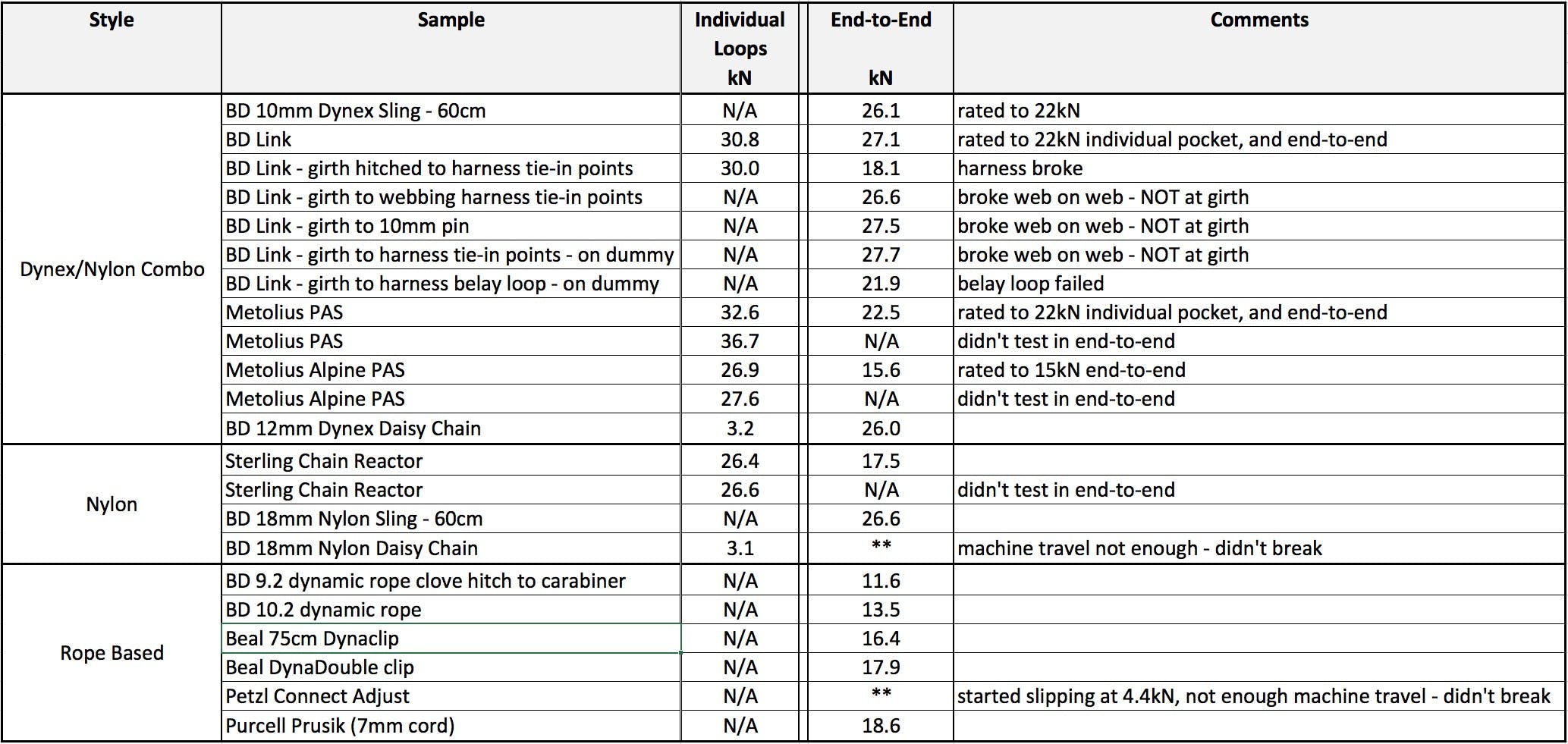
Comments – Static Tests
Static Tests – Individual Pockets, and end-to-end
- For commercial products designed with individual loops – the loops are burly strong
undefined - For commercial products when tested in end-to-end configuration, all are strong – as strong as all the manufacturers claim, and plenty strong to deal with normal-use loads.
- Girth hitching to the tie-in points of your harness is stronger than girth hitching to your belay loop. More on that below.
- The rope-based systems were generally not as strong in ultimate strength when tested in end-to-end configuration, but once again plenty strong for normal use.

RESULTS - DYNAMIC TESTS
60cm tether, FF0.5 and FF1
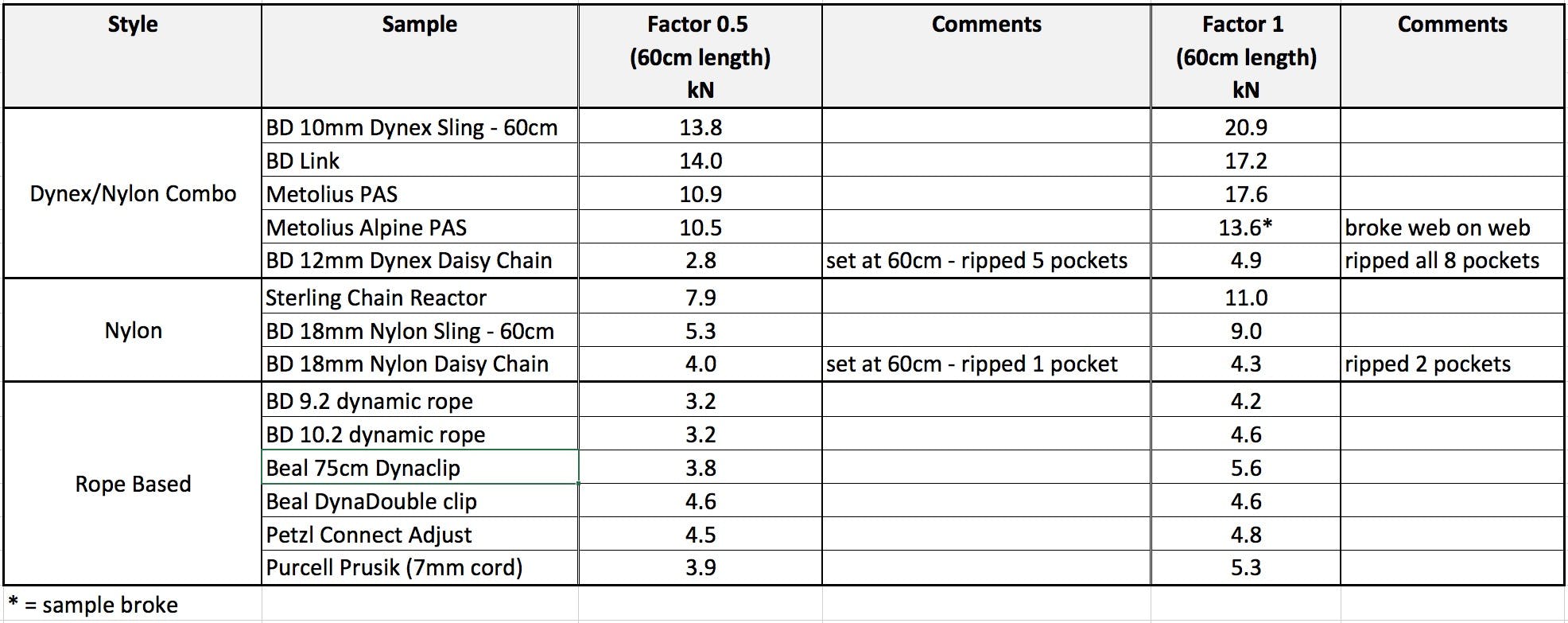
Comments – Dynamic Tests
60cm tether, FF0.5 and FF1
- In general, the Dynex products result in higher impact forces than Nylon products and the rope systems result in the least. Checks out.
undefinedundefinedundefinedundefined - In general, the FF1 results in higher loads than the FF0.5 – checks out too. A harsher fall will result in higher loads. Not as noticeable when using a rope or in the rope based systems as once again, ropes are intended to absorb energy in a dynamic loading situation.
- When testing a daisy chain, pockets ripped absorbing energy resulting in a relatively low load.
CONCLUSIONS
Static Tests
- 1. All of these personal anchor systems are plenty strong to do what they need to do—anchor you.
undefined - 2. The individual pockets of a daisy chain are not strong, and not intended to be. Don’t think that you’re clipping into something burly strong when you’re clipping into an individual pocket of a daisy chain.
- 3. When girth hitching to your harness, girth hitch to the tie-in points, not the belay loop—once again—more on that below.
Dynamic Tests
- 1. Dynex doesn’t stretch, resulting in higher loads. If KP takes a Factor 1 fall onto a 60cm Dynex sling when descending a route, it’s gonna hurt.
- 2. The more nylon in the system, the more energy it’ll absorb, reducing the load. If I used a 60cm Nylon sling, and slipped, the loads would be greatly reduced.
- 3. The Dynex based chain of loops styles are stronger in ultimate strength than nylon based, but result in higher loads in dynamic testing—makes sense because Dynex is super strong, but doesn’t stretch.
- 4. Using the rope or rope based systems result in the lowest loads seen. So, if KP is tied in using the rope on his way up a multi-pitch climb and falls onto the anchor, it’s not gonna hurt too much.
- 5. Though the pockets ripping on a daisy chain result in a low load, it is not recommended to use a daisy chain as an energy absorbing system or ‘screamer’. If you were to barely shock load when clipped into a pocket of a daisy, you’re gonna blow the pocket, and scare the crap out of yourself, and render the daisy useless. And as I mentioned above, the possibility of mis-clipping a daisy is real (see video). Daisy chains are intended for use while aid climbing.
FUTURE TESTS
As I said above, this is far from conclusive. An eager engineering student could do their fourth-year project on variants of these tests including:
- Simply including more data points of similar configurations
- Full extension tests instead of 60cm
undefined - Fall Factor 2
undefined - Incorporate more real-world testing (i.e. Include harness and person into the equation)
- More comparison of girth hitch to harness reduction in strength to looping around 1” steel pins
- Etc., etc.
PRO-TIP
I often get asked if it’s best to girth hitch a sling or Personal Anchor System to your belay loop or your tie-in points. Of course you should always follow the specific manufacturer's recommendations, however, here at BD, we recommend girth hitching to BOTH of your tie-in points.
Personal Anchor System Instructions
Here’s the rationale:
I like the rule of thumb that the ACMG (Association of Canadian Mountain Guides) uses: belay loops for metal (i.e. carabiners) and tie-in points for fabrics (i.e. ropes and slings). It just keeps your belay loop nice and clean for what it’s used for… belaying.
Also, if you were to girth your tether to your belay loop, then really what you’ve done is limited its ability to rotate. This can result in excessive wear on the underside of the belay loop which is not easily visible. In the worst case, this could lead to an accident similar to what tragically happened to Todd Skinner many years ago when he had a daisy chain semi-permanently girth hitched to his belay loop which eventually wore through.

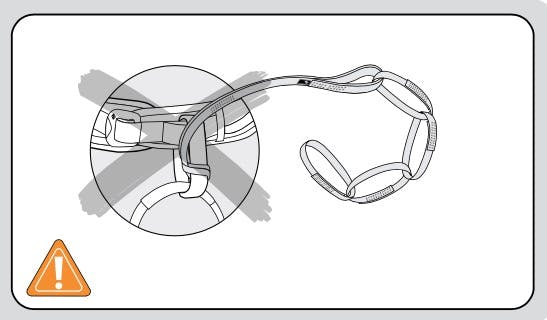
SPECIAL THANKS
A special thanks to Matt Berry, one of our crack crew of BD Quality Engineers who spent his afternoon in the drop tower breaking this stuff for us. And to another one of our gear destroyers, Matt Tetzl, for breaking these samples in our tensile tester. (Yes, we have a lot of Matts here at BD.)
And once again, I’d like to thank our friends at Metolius, Sterling, Petzl and Liberty Mountain for providing their anchor systems for this post.
BOTTOM LINE
I’m still old school and still use a clove hitch to tie into the anchor with the rope, because I have it with me. But if you’re a climber that likes the security of a Personal Anchor System, that’s awesome—just know as I said above you should always try to avoid putting yourself in situations where you can shock load the system—because you’re gonna feel it.

Be safe out there,
KP
FEATURED GEAR



